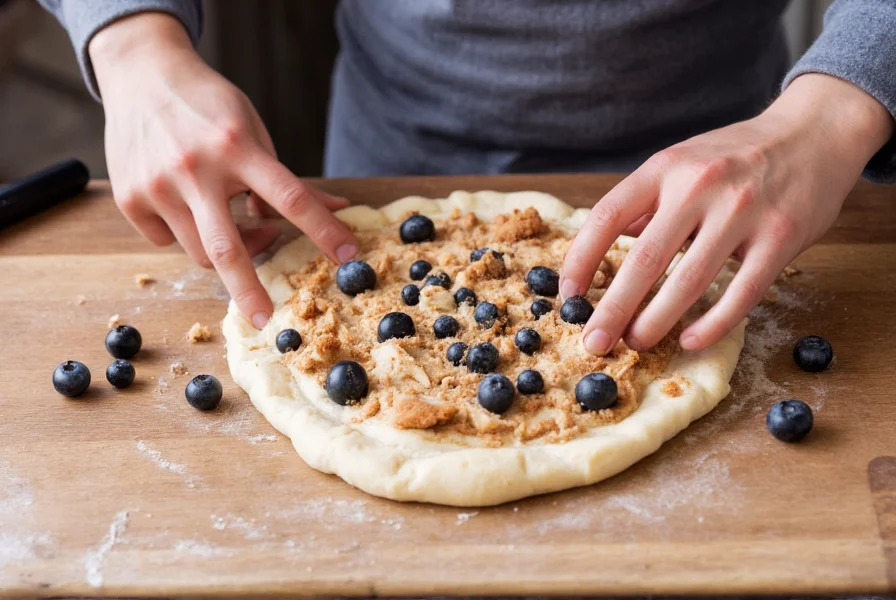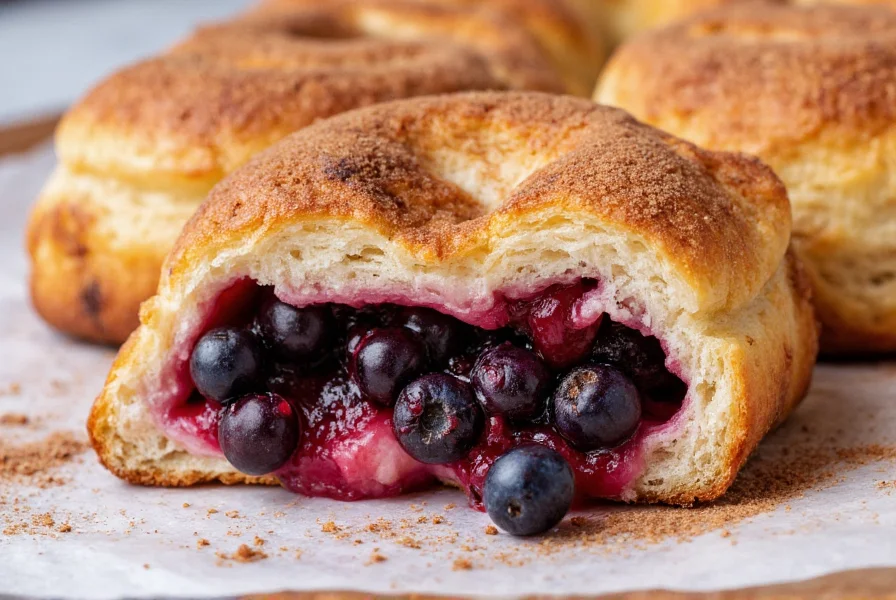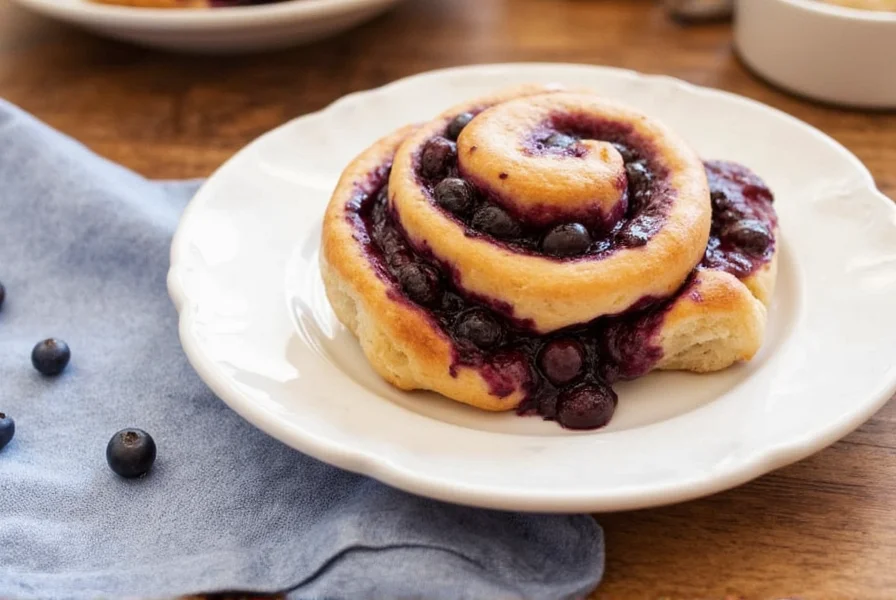Blueberry cinnamon buns represent the ideal fusion of sweet fruit and warm spice, creating a breakfast pastry that's both comforting and sophisticated. While many home bakers struggle with common issues like soggy bottoms, bleeding filling, or dense texture, mastering this recipe requires understanding the science behind each component and how they interact during the baking process.
The Science Behind Perfect Blueberry Cinnamon Buns
Creating exceptional blueberry cinnamon buns isn't just about following steps—it's understanding why each element matters. The magic happens through careful balancing of moisture, structure, and flavor development.
Why Blueberries Pose Unique Challenges
Fresh blueberries contain approximately 85% water, which creates significant challenges when incorporated into cinnamon buns. Unlike traditional cinnamon roll fillings, fruit introduces excess moisture that can:
- Prevent proper dough rising during proofing
- Create soggy bottoms after baking
- Cause filling to bleed into the dough
- Lower the internal temperature of the bun
Professional bakers address these issues through strategic preparation techniques that maintain the fruit's integrity while controlling moisture release.

Essential Ingredients Analysis
Not all ingredients are created equal when making blueberry cinnamon buns. Understanding their roles helps you make informed substitutions without compromising quality.
| Ingredient | Function | Quality Considerations | Substitution Options |
|---|---|---|---|
| All-purpose flour | Provides structure through gluten development | Choose unbleached for better flavor development | Bread flour (increase liquid by 5%) |
| Fresh blueberries | Primary flavor component | Firm, dry berries prevent excess moisture | Partially frozen berries (toss in cornstarch) |
| Cream cheese | Enriches dough and balances acidity | Full-fat blocks, not spreadable tubs | Mascarpone (slightly sweeter profile) |
| Instant yeast | Rising agent | Fresh packets for reliable activation | Active dry yeast (increase liquid by 10%) |
Step-by-Step Professional Method
Dough Preparation: The Foundation
The dough's hydration level directly impacts your blueberry cinnamon buns' texture. Aim for 65-70% hydration (65-70g water per 100g flour) for optimal elasticity without becoming sticky. Professional bakers use the windowpane test to verify proper gluten development—stretch a small piece of dough until thin enough to see light through without tearing.
Temperature control during mixing matters significantly. Keep your dough between 75-78°F (24-26°C) after mixing. Warmer temperatures accelerate fermentation but risk developing off-flavors; cooler temperatures slow the process but enhance flavor complexity.
Blueberry Filling Technique
The secret to preventing blueberry bleeding in cinnamon buns lies in proper filling preparation. Simply tossing fresh berries onto the dough guarantees a purple mess. Instead, follow this professional approach:
- Toss 1½ cups fresh blueberries with 1 tablespoon cornstarch and 2 teaspoons lemon zest
- Spread ¼ cup thick blueberry jam (not syrupy) across the rolled dough
- Sprinkle cinnamon-sugar mixture evenly over the jam
- Distribute the cornstarch-coated berries evenly, leaving ½ inch border
- Roll tightly from the long edge, using a bench scraper to help lift
This layered approach creates a moisture barrier that protects the dough while allowing the berries to maintain their shape during baking. The cornstarch absorbs excess liquid as the berries cook, transforming into a thick, jam-like consistency rather than a watery mess.

Troubleshooting Common Problems
Even experienced bakers encounter issues with blueberry cinnamon buns. Understanding these problems and their solutions separates good results from exceptional ones.
Soggy Bottom Syndrome
This frustrating issue occurs when excess berry moisture accumulates at the bun's base. Prevent it by:
- Using partially frozen berries (not thawed)
- Adding 1 teaspoon tapioca starch to the filling
- Baking on a preheated baking stone or heavy-duty sheet pan
- Allowing buns to cool vertically in a muffin tin for 10 minutes post-bake
Bleeding Blueberries
When blueberry juice migrates into the dough, creating unappetizing purple streaks, it's usually due to:
- Overripe berries with thin skins
- Insufficient thickener in the filling
- Rolling the dough too tightly, crushing berries
The solution? Toss berries in cornstarch before assembly, use firm berries, and roll gently without excessive pressure.
Advanced Techniques for Exceptional Results
Professional pastry chefs employ several advanced techniques to elevate their blueberry cinnamon buns beyond the ordinary.
The Double-Proof Method
For superior texture and flavor development, implement a two-stage proofing process:
- First proof: Allow shaped buns to rise at room temperature until 50% increased in size (about 45-60 minutes)
- Refrigerate overnight (8-12 hours) to develop complex flavors
- Bring to room temperature and complete rising (about 30 minutes) before baking
This technique enhances flavor complexity while improving the bun's structure and crumb texture. The cold fermentation allows enzymes to break down starches into simpler sugars, creating more nuanced flavors and better browning.
Temperature-Controlled Baking
Professional results require precise temperature management:
- Preheat oven to 375°F (190°C) with baking stone inside
- Bake for 18-22 minutes until internal temperature reaches 190°F (88°C)
- Rotate pan halfway through baking for even cooking
- Use an oven thermometer to verify actual temperature
Many home ovens have hot spots or inaccurate thermostats, which explains why some blueberry cinnamon buns bake unevenly. An inexpensive oven thermometer solves this common problem.
Serving and Storage Recommendations
Blueberry cinnamon buns taste best when served within 2 hours of baking, but proper storage maintains quality longer. Allow buns to cool completely before storing to prevent condensation. For optimal freshness:
- Room temperature: Store in airtight container for up to 2 days
- Refrigerated: Wrap individually and refrigerate for up to 5 days
- Freezing: Wrap tightly and freeze for up to 3 months
To refresh day-old buns, place on a baking sheet and warm in a 300°F (150°C) oven for 8-10 minutes. This restores the soft texture without drying out the pastry.
Variation Ideas Worth Trying
Once you've mastered the classic blueberry cinnamon bun, experiment with these professional variations:
- Lemon-Blueberry: Add 1 tablespoon finely grated lemon zest to the dough and 2 teaspoons to the filling
- Blueberry-Cream Cheese Swirl: Pipe thin lines of sweetened cream cheese between the filling layers
- Bourbon-Infused Blueberry: Simmer berries with 1 tablespoon bourbon and ½ teaspoon vanilla before using
- Whole Grain Option: Substitute 30% of the flour with whole wheat pastry flour
Frequently Asked Questions
How do you prevent blueberries from bleeding in cinnamon buns?
Prevent blueberry bleeding by tossing fresh berries in cornstarch before assembly, using firm berries rather than overripe ones, and creating a moisture barrier with a thin layer of blueberry jam beneath the cinnamon sugar. The cornstarch absorbs excess liquid as the berries cook, transforming into a thick, jam-like consistency rather than a watery mess.
Can I use frozen blueberries for cinnamon buns?
Yes, you can use frozen blueberries, but they require special handling. Partially thaw them first, then toss with cornstarch to absorb excess moisture. Never use completely frozen berries as they'll release too much water during baking. Professional bakers often prefer slightly under-ripe fresh berries for better structure retention during baking.
Why are my blueberry cinnamon buns soggy on the bottom?
Soggy bottoms occur when excess berry moisture accumulates at the bun's base. Prevent this by using partially frozen berries tossed in cornstarch, adding tapioca starch to the filling, baking on a preheated baking stone, and allowing buns to cool vertically in a muffin tin for the first 10 minutes after baking to promote air circulation.
How long should blueberry cinnamon buns rise before baking?
Blueberry cinnamon buns should rise until they've increased by about 50% in size, which typically takes 45-60 minutes at room temperature (70-75°F). They're ready when gently pressing a finger into the dough leaves a slight indentation that slowly springs back. Over-proofing causes structural collapse during baking, while under-proofing results in dense texture.
What's the ideal internal temperature for baked blueberry cinnamon buns?
The ideal internal temperature for perfectly baked blueberry cinnamon buns is 190°F (88°C). Using an instant-read thermometer inserted into the center of a bun ensures they're fully baked without overcooking. Baking to temperature rather than time accounts for variations in oven accuracy and bun size, guaranteeing consistent results.











 浙公网安备
33010002000092号
浙公网安备
33010002000092号 浙B2-20120091-4
浙B2-20120091-4